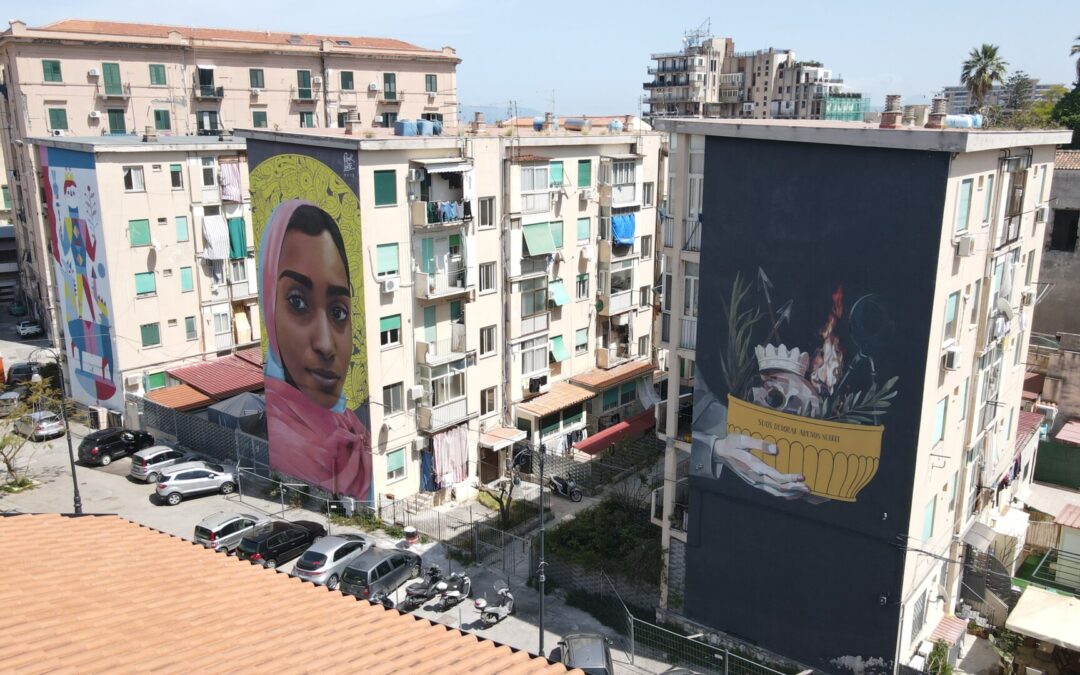Palermo Street Art
In part one of our series 'Streetart Palermo' we report about street art in Palermo's old town district Ballarò. In part three we will cover the old town district of La Loggia, as well as the Capo district.
If you don't know this 1st part yet, we recommend to start with this. You can find the link here or at the end of this post.
But for now, let's turn our attention to the murales in the Kalsa.
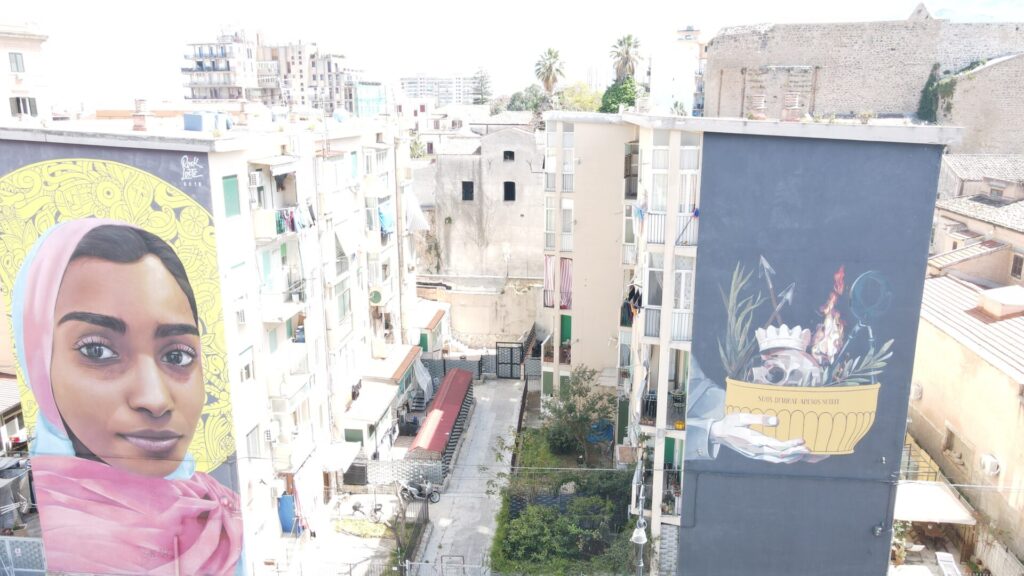
Street Art: Tribunali o Kalsa
What can you do with three 28-meter-high and 15-meter-wide windowless facades of three blocks of public housing?
In Via dello Spasimo, they transformed it into a canvas as part of a project sponsored by the Fondazione Federico II. The common theme: hospitality and integration.
"St. Rosalia"- Lucio Bolognesi - Basik
This mural in Via dello Spasimo is by Lucio Bolognesi. Artist name Basik.
The work shows several objects that are supposed to be related to St. Rosalia, as well as other patron saints of Palermo. Besides the Signore, at least one patron saint makes it onto this mural. It is the Genius of Palermo, an ancient patron saint that probably dates back to pre-Roman times.
Basik's murals often blend images from the Middle Ages, the Renaissance, and modern and contemporary art. In the late nineties, he was considered one of the most influential street artists in Italy.
Since you can find contradictory information on the net about the items shown, we asked someone who knows about it and that is Basik himself.
We got an answer super fast:
"Santa Rosalia is actually represented by the skull, the crown represents the Genius of Palermo. The other symbols refer to the other patron saints.
Christina, Agatha, Nymph and Olive. - The inscription on the gilded vessel is also associated with a statue of Genius, on which is an inscription of which the phrase on the painting is a part."
Very sympathetic! Especially that he could still remember that the depicted tongs, referred to St. Agathe. The other objects he no longer knew so exactly.
Very cool to just admit that you don't know something or don't know something anymore. Others would have told some nonsense now. After all, Basik is an artist and not a history professor.
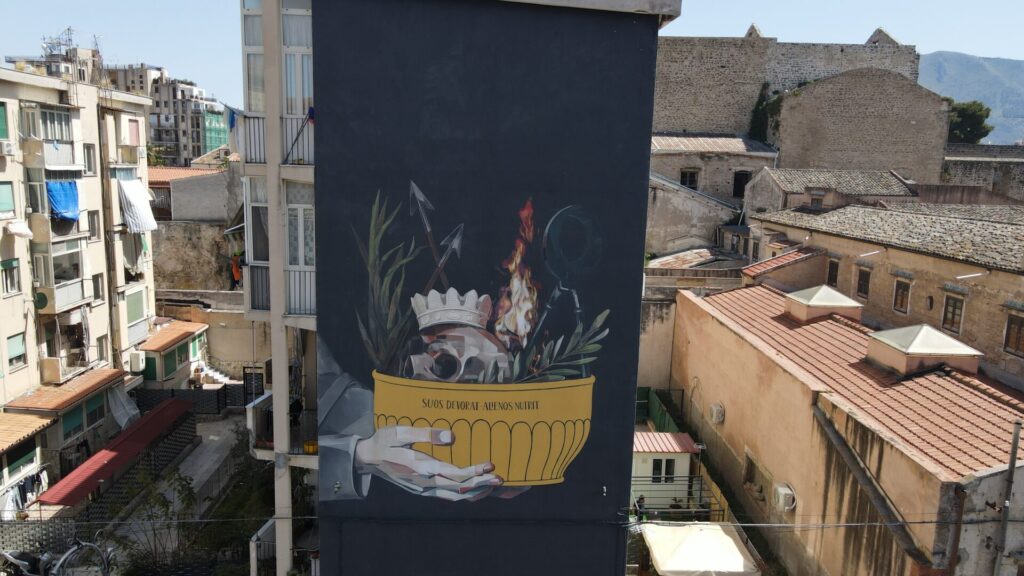
But curiosity got the better of me, and I had to do some research. - Where would we be without the Internet? One thing quickly became clear. To be canonized means having to suffer pain. Not such a great job.
Santa Agatha
lived approximately from 230 to 251 AD. She died in agony from torture. By means of the depicted forceps her breasts were amputated. Afterwards she was burned.
Santa Cristina
lived around 304 AD. Because of her Christian faith, she was not only locked up in a tower by her own father, but subjected to countless tortures. According to legend, she survived a burning wheel, as well as the attempt to drown her. But the two depicted arrows, your saint attribute, she then but no longer survived.
"They come every day and deface our cities.
They leave their idiotic writing everywhere.
They make the world an ugly place.
We call them advertising agencies and urban planners."
Banksy
Santa Ninfa
was born in Palermo at the time of Constantine, according to a 12th century writing. She was the daughter of the prefect Aureliano. That Ninfa converted to Christianity after the preaching of Bishop Mamiliano of Palermo, her father did not like at all.
You can certainly guess, she was also imprisoned and tortured on the orders of her father. There followed the miraculous intervention of an angel. He freed Ninfa and brought her first to Rome and then to the island of Giglio. But there is no happy ending for saints. Shortly after, she starved to death in a hermitage.
Her head was taken to Palermo Cathedral and placed under an altar. Her saint attribute is the skull represented.
Sant'Oliva
was born in Palermo in 448 AD. Allegedly, she traveled to Tunis. There, the Sultan Amira also subjected her to torture and abandoned her in the desert. After she survived sun and wild animals, more torture followed. At last Olivia was beheaded. Her saint attribute is the olive branch depicted.
You see, saints don't have a dream job. Not even in Palermo. But for that you get a saint figure at the Quattro Canti. So far, I just thought Basik's mural was cool. From now on, I'm sure I'll shudder a little when I walk past it in the future.
Sorry if it was too detailed. - But warn't the theme hospitality and integration?
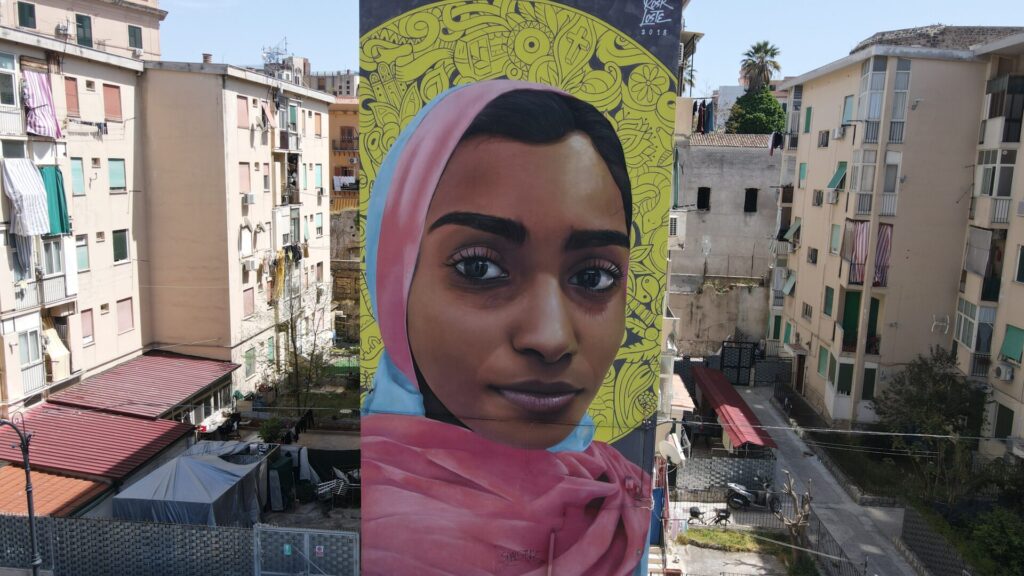
"Bakhita" - Rosk & Loste
This work comes from Maurizio Giulio Rosk and Gebbia & Mirko Lostecalled Rosk & Loste. All are artists, from the Sicilian town of Caltanissetta. They are united by street art and their joint studies at the Academy of Fine Arts in Palermo. In the meantime, they enjoy international recognition. They made it, for example, to Rolling Stone magazine.
Her work Bakhita is a large-scale photorealistic work. The first thing that should catch your eye are the sparkling eyes of the young woman depicted. The woman with non-European features perfectly embodies the theme of integration. Behind the head of the girl is placed a halo. So to speak, an urban saint.
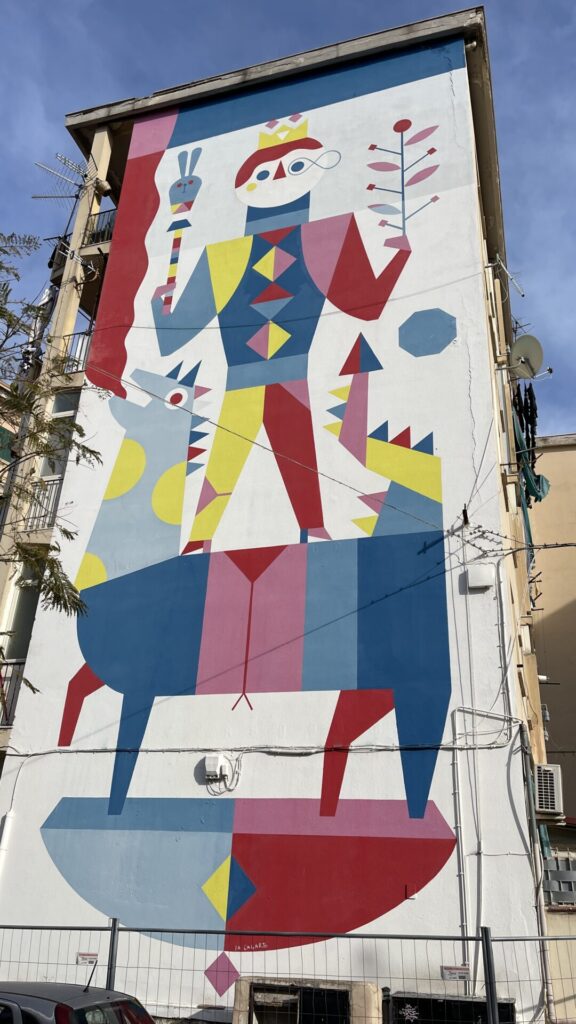
"Federico II" - Camilla 'Falsini
Camilla Falsini created the third work from this series. She was born in Rome. There she lives and works today as a painter and illustrator.
The mural shows a child with his swinging dragon, named Drago. According to the artist, this symbolizes 'Nico' (Sicilian meaning "small"). As well as the openness of the Kalsa to religions, cultures, sciences and arts.
Every person is a NICO, he said, you only need to wish and welcome him. The idea is therefore a tribute to this historical figure, as a symbol of welcome, inclusion and curiosity.
Like all art, street art either unites or divides. Personally, I can't get much out of this work. The artist doesn't seem to be entirely convinced either. On her website you can find a large number of murals from various years. This work is not one of them.
Maybe she was just having a bad day. - What makes me think that? The work bears a kind of signature: "Fa Cagare", which means something like "it sucks" or "it sucks". I don't think it's quite that bad. But as I said, art either unites or divides. - What do you think?
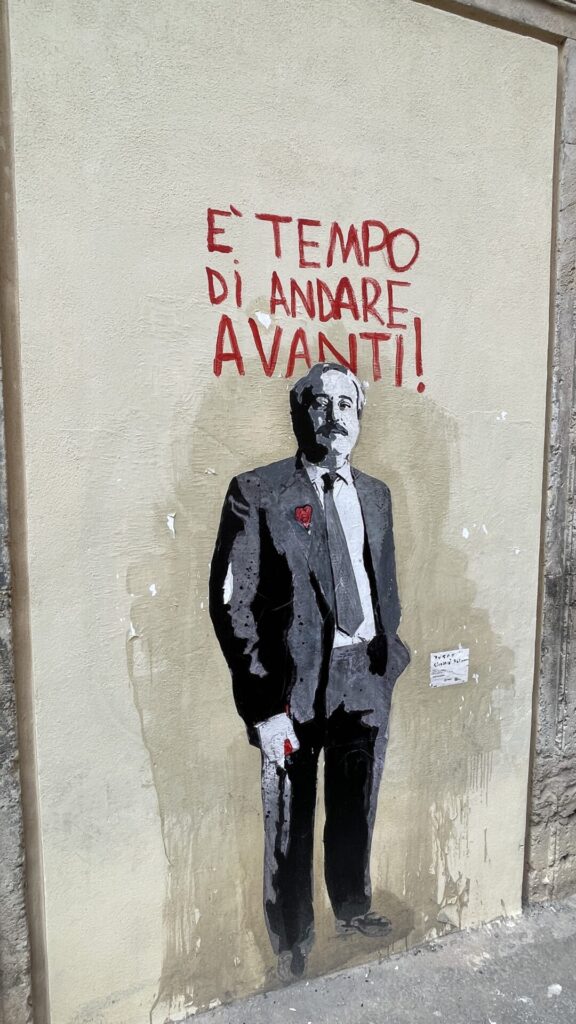
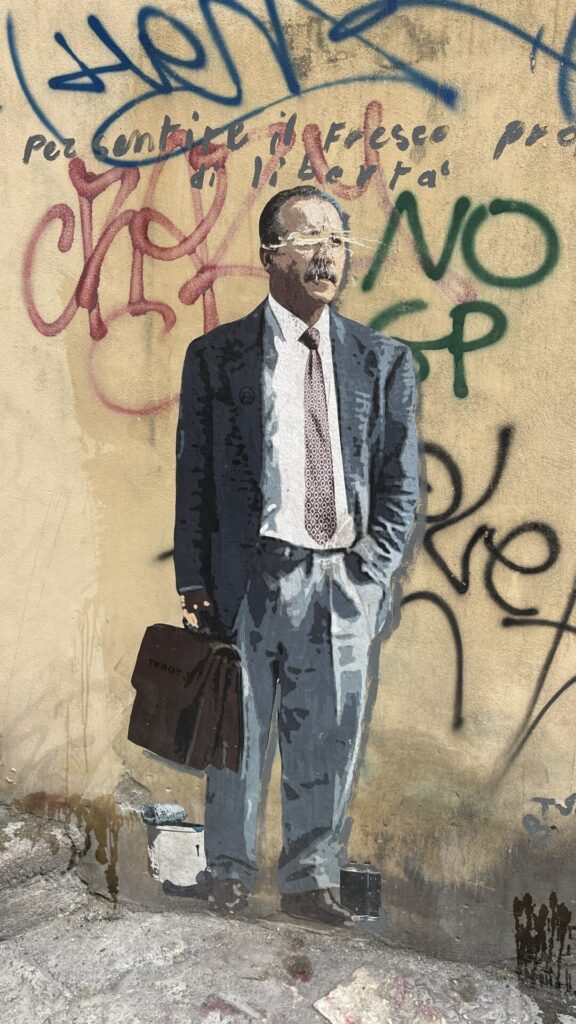
"E tempo di andare avanti" - TvBoy
The Sicilian street artist Salvatore Benintende, artist name TvBoy, pays homage to the former mafia judge Giovanni Falcone with these words. They mean something like "It's time to move on!"
The work was created on the anniversary of the bomb attack. The terrorist attack by the Sicilian mafia, which took place on May 23, 1992 on the A29 highway near the Capaci exit in Sicily, made Falcone a martyr to his cause.
The street art scene always manages to "revive" the judges with a spray can. The work in Via Lungarini is located in the immediate vicinity of Piazza Marina.
Not far away, in Piazza Cattolica, TV Boy has also immortalized Judge Paolo Borsellino. Like Falcone, Judge Borsellino was also murdered by the Mafia in 1992. The Mafia no longer has any friends in the Kalsa? Why do you think the judge's eyes were scratched out?
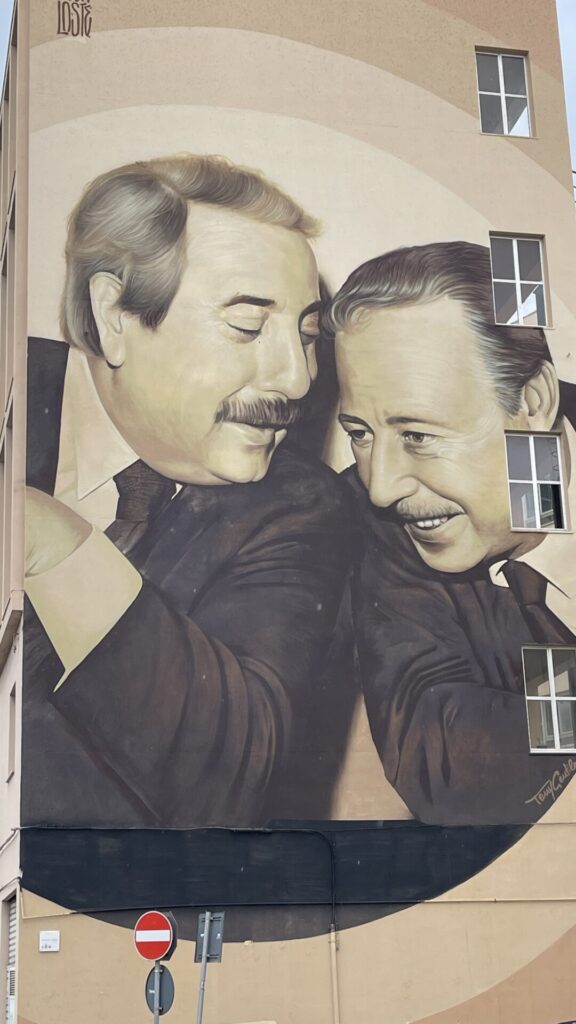
"Falcone e Borsellino" - Rosk & Loste
This mural was also created by the Palermo artists Rosk & Loste. It's worth taking a look at their Instagram accounts.
It also depicts the murdered Italian judges and mafia hunters Giovanni Falcone and Paolo Borsellino, here in conversation. The mural was based on a photo taken in Palermo on March 27, 1992 by the Italian photographer Tony Gentile. Just a few months before the bomb attack.
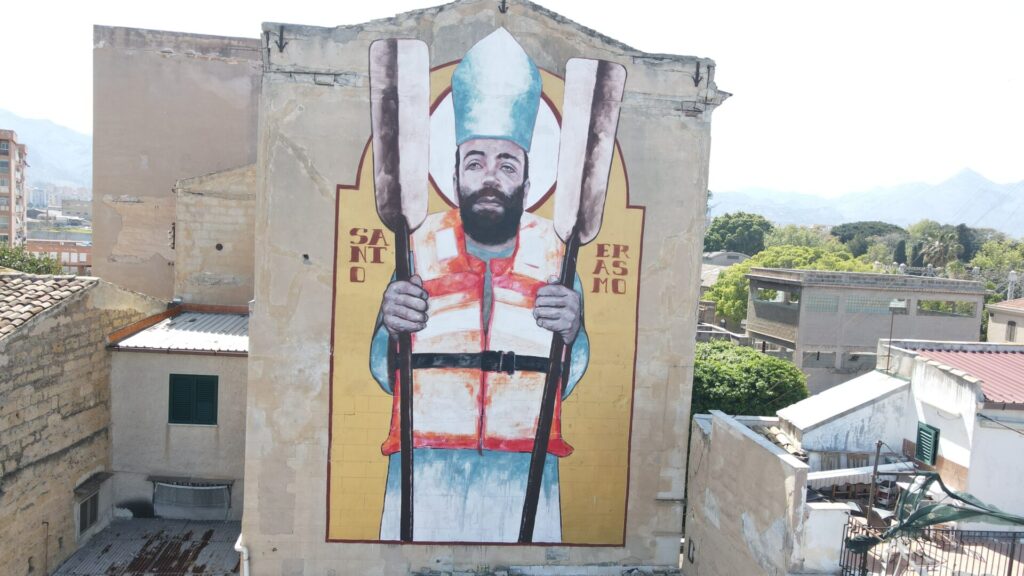
"Sant' Erasmo" - Igor Scalisi Palminteri
Igor Scalisi Palminteri painted another saint on the edge of the Kalsa, directly opposite the small harbor, Porticciolo di Sant'Erasmo. - After San Benedetto il Moro and Santa Rosalia, both in Ballarò, a picture of the patron saint of fishermen has now been created here.
However, both the holy vestments and the pastoral (shepherd's crook) are missing. Instead, there are oars and an orange lifebuoy (symbolizing the rescue of migrants at sea).
The artist dedicated the mural to "all the people who were involved in the rescue of migrants at sea".
Quote from Igor Scalisi Palminteri: "The fisherman of men welcomes and protects those who arrive in Palermo by sea"
In this context, we learned something about Igor Scalisi Palminteri's past as a Franciscan monk. This certainly reveals his often Christian motives, as well as his strong social commitment.
"When they asked me to do a mural in Sant'Erasmo, I immediately thought of the words of Jesus Christ: "I will make you fishers of men"."
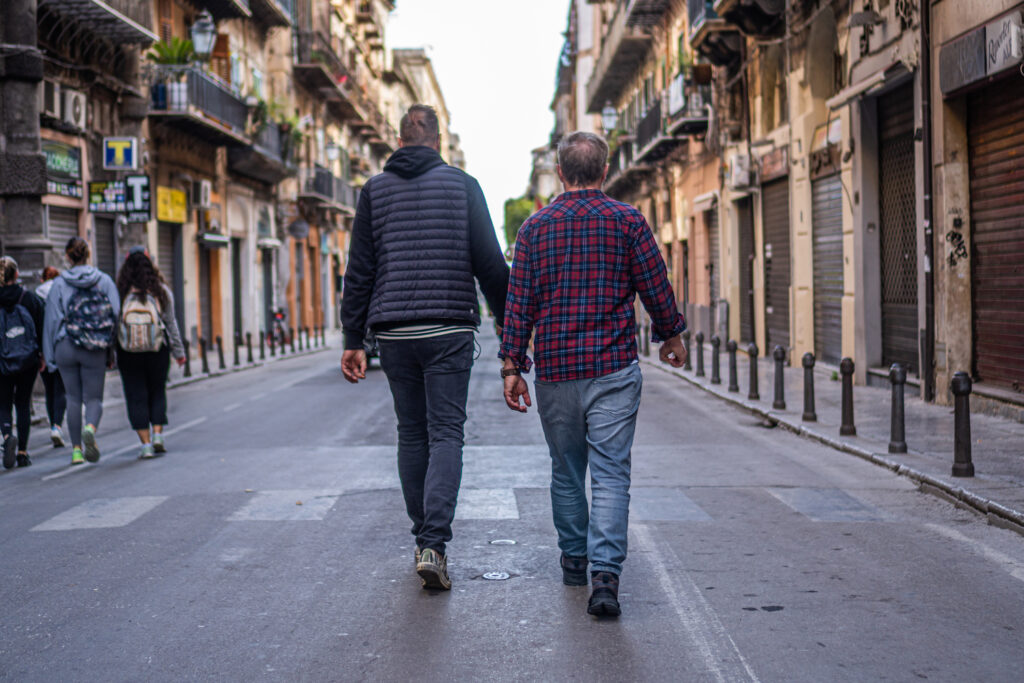
Snapshot
On the one hand, murals are transient; on the other, Palermo's street artists are extremely active. We therefore see this article as a snapshot or stocktaking. Help us by drawing our attention to old or new works. This way we will at least get one or the other work. Thank you!
You want more? - There is still a lot to discover.
Added value - Links
Ciao, traveler and connoisseur! If you are looking for the perfect home away from home in Palermo, we have just the thing for you: Palazzo Vetrano, an exceptional apartment in the heart of the old town. Here you can expect historical charm, modern comfort and an unbeatable location in the Centro Storico.
And that's just the beginning! Dive deeper into the vibrant world of Palermo and discover that the Centro Storico is more than just an ordinary old town. Join us further to Mercato di Ballaro, where you will not only find street food, but also taste a piece of Palermo's soul. But beware: Palermo street food can be addictive!
When you've had enough of feasting, let yourself be enchanted by Palermo's street art. Here, walls become canvases and graffiti becomes works of art. And if you want to feel the adrenaline in your veins, experience the Targa Florio - a street race that makes Sicily shake! Would you rather discover a small fishing town? - How about Cefalù? - So, discover the diversity of Palermo and Sicily.
Start here:
- Palazzo Vetrano - The somewhat different vacation apartment
- Palermo Centro Storico: More than just an old town?
- Mercato di Ballaro: Palermo's oldest market
- Palermo Street Food:
- Street Art Palermo: Part I or Part II or Part III or Part IV and to round off Part V
- Targa Florio Part I and Part II - THE race
- Cefalù - More than a fishing village
- Madonie - You love Nature, small villages and delicious and local cuisine
And if you want to retire after an exciting day, Palazzo Vetrano, the perfect vacation apartment in Ballaro, Palermo Old Town, awaits you. Here you can relax and plan new adventures. Book today and make your dream vacation come true!

